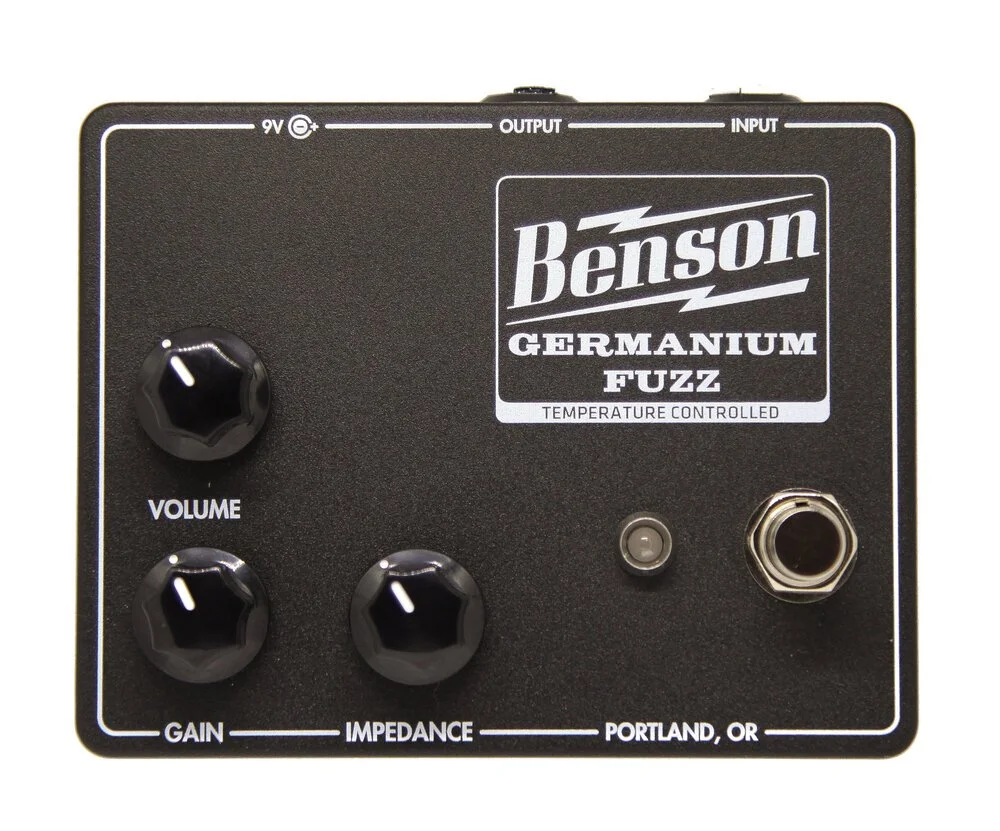Benson Germanium Fuzz
After many months of waiting, it finally arrived. Regular readers already know that I am not a fuzz guy. For the most part, the sound of fuzz just gives me a headache. So why the interest in this fuzz pedal, especially when I have three others, two in use?
Besides my challenge of finding most fuzzes very non-musical, taking away from the song rather than adding to it, traditional fuzz design requires a fuzz to be first in your pedal chain, otherwise they sound even worse. This would not be an issue, except that other pedals such as treble boosters also need to be first and as we learned in Highlander, there can only be one. Germanium transistor based fuzzes came first and there is this myth around them that the best musicians only liked germanium fuzzes. Given that the musician probably best known for fuzz was Jimi Hendrix and that it is well documented that Mr. Hendrix preferred silicon based fuzzes puts the boots to this myth. Silicon came later and was used for a couple of good reasons. The first was stability, a silicon fuzz would sound consistent from day to day, month to month, location to location. Germanium fuzzes are more inconsistent. The second was temperature sensitivity. The temperature of a germanium transistor has a huge effect on its sound, so getting that transistor into its best performing range is hugely important.
Chris Benson addressed both these issues. The Benson Germanium Fuzz uses unique design to get the transistor to the optimum temperature and then keeps it there. If the LED is green, the temperature is optimal and if orange, the system is working to get the transistor where the designer wants it to be for optimum tone. I’ve wasted a lot of time on germanium fuzzes in evaluation that don’t do this and the variance in tone is quite off-putting. The enclosure is available in white or black and I cannot understand why anyone would buy black as it absorbs more heat and is more likely to make the transistor too hot for good sound. I ordered mine in the white case. I suppose that if you only ever played in a dark cool place that the black enclosure would be fine, but physics matters more to me than cosmetics.
The second thing is that by adding a circuit element that ensures that the input sees the kind of loading expected from a magnetic pickup, Benson has removed the necessity for the Benson Germanium Fuzz to be first in the chain. I have tested this and it works beautifully. Moreover, there is a variable impedance control so you can tune the input impedance to give you the fuzz that suits you well. The control is nicely granular and it’s easy to find optimal tone. This is even more valuable if the fuzz is first and you are switching guitars perhaps from low output single coils to high output humbuckers. With a little bit of prep, you can find the optimal impedance control setting for your guitar.
In the image above, you can see the simple control layout. In addition to the footswitch, the temperature LED and the Impedance control, you have Gain and Volume. The last two do what you expect. What one can miss and should not, is the level of interactivity between the Gain and Impedance controls. This pedal can do between a fairly clean boost, a nice overdrive and a very fuzzy yet still musical fuzz. If you are seeking massive levels of distortion or a spitty kind of fuzz, look elsewhere, as you will not find those sounds here. I keep coming back to the adjective “musical”.
While fuzz portion of the circuit is very simple and one might call it “classic”, the thermal control and impedance control sets the Benson Germanium Fuzz apart.
I have found two other fuzzes that I liked, the Effectrode Mercury which is tube based and the Wampler Velvet Fuzz. I think that the Benson Germanium Fuzz is the nicest to my ear. You may find it so as well. Thanks for reading, if you have any questions, post them here and until next time, peace.


